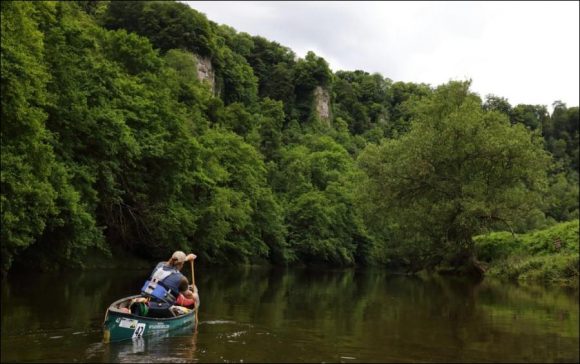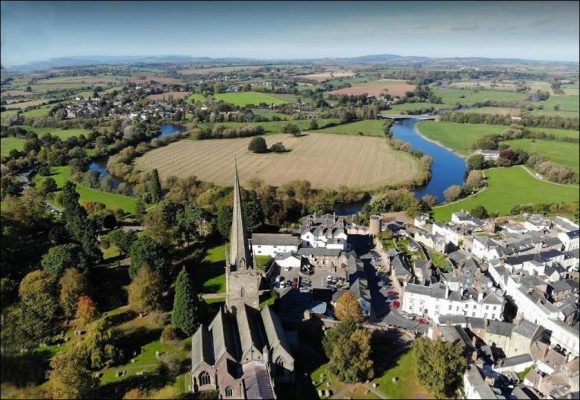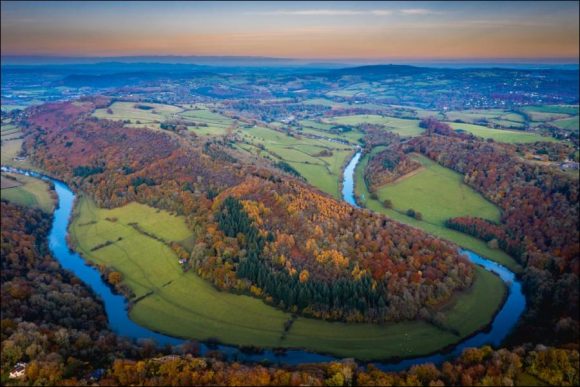Nearly 250 years ago, the enthusiasm of an Anglican cleric for the beauty of the river changed the way we travel. Canoeing is a great way to celebrate your pioneering legacy.
I rarely find myself expressing my gratitude to an eighteenth-century vicar, but as our canoe slides down the meander of the river, I silently thank a certain William Gilpin. To our left, a jungle of ancient trees rises in an impressive cliff; on the right there are meadows and low hills. In the heavens above a solitary buzzard sails.
“This is the famous point of view,” says our guide Stuart, pointing to the ridge above the cliffs, “Symonds Yat. Beyond that, we have the rapids, then one of the sections I like best: the massacre, a huge river curve with a deep forest on both sides.”
Without Gilpin, the conversation could be very different. The rocks would be abominable, the forest dark and depressing, the rapids impracticable and Stuart would have been described as dangerous crazy to drag travelers like his son Niall and myself in such a horrible place.
Gilpin, you see, has been a pioneer in discovering beauty in natural and raw places, especially here on the Wye River. Without him and some other romantic souls, we could all be frightened cats without blood hidden in our living rooms and admiring the wallpaper. In 1770, he undertook a tour of the Wye River, an expedition that would lead to his book, Observations on the Wye River, and would not only trigger a wave of tourism in the river, but would also advise the public on how to look at what was in front of them. In many ways, the year 2020 marks the 250th anniversary of tourism in Britain and how we take advantage of the British countryside: a year of celebration is planned along the river.
A river landscape by William Gilpin. A photograph: Alamy
By modern standards, Gilpin’s prose reads like a sermon, but at the time, his rapture in wild “rubble” and “splendid ruins” was revolutionary. Writers and artists flocked to it. Coleridge blessed Gilpin for alerting us to “the beauty and wonders of the world,” while in Tintern Abbey, Wordsworth enjoyed one of his “historic moments,” a moment of ecstatic bliss in nature.
O sylvan Wye! thou wanderer thro’ the woods,
How often has my spirit turned to thee!
Our own attempt to reach a state of happiness on the Wye has been delayed by rain and floods. The first day’s canoe being canceled, we start from the first to the second camp in front of the White Lion Inn in Ross-on-Wye. At least we could still spend two days on the water.
I must say that the White Lion is a campsite as good as you would like: a green lawn between a decent pub and a beautiful river, next to a 15th century pink stone bridge whose arches are submerged by swallows and martens. (In winter, the campsite is closed – March 15, it opens on March 15 – but the pub has double rooms £ 75 half board.) We walk in Ross, a mix of old palaces in timbered and modern shops. What would Gilpin say? In fact, he complains that the city has no vision worthy of its ultimate reward – “picturesque”.
“He has no characteristic objects,” he laments. “There are too many broken pieces; she [the view] is seen from too high. We leave the old curmudgeon grumbling in the cemetery and going to have a pizza.
The next morning, Stuart decides that the level of the river has dropped enough and we start from the bottom of the city, paddling and drifting quickly downstream. The banks are invisible, trees surrounded by gurgling muddy water. We finally arrive at the long turns around Symonds Yat, a beautiful section of the river that leads to the old Ferrie Inn for a late lunch. Beyond that, the Saracens Head (double from £ 100 B & B) is close to our night stop, a pub that offers a hand-pulled ferry and beer. Niall and I take the opportunity to climb the hill through the woods, emerging to the famous point of view.
In the midst of the crowds at the top, we observe the late silvery sun on the river far below. It is the most magnificent sight, even though Gilpin’s delicate eyes are dismayed by the rocks not adorned with moss or lichen. Better for climbing, I say. Some are even buried in the ground, which is particularly disgusting for the Reverend. “Lumpish and the less picturesque,” he chuckled.
Then, miraculously, the noise of the voices subsides and we have room for ourselves. Niall sees a pilgrim rushing through the sky like a meteorite, then lowering and plunging abruptly at breakneck speed. It’s like one of Wordsworth’s temporal spots, indelibly engraved in my memory and knowing the position of the poet himself 200 years ago.
The next morning, we start with a treat: the rapids. In fact, with the river so high, warns Stuart, it will not be as “interesting” as normal. Nevertheless, the accumulation is impressive: the river is narrowing, the water becomes glassy and reflected, then develops suddenly, a frown, that we start to slow down by bouncing in the waves. It’s just time to think, “I’m really happy the water was so high,” before we were spit into peaceful pools.
We then enter the Abattoir, an idyllic river that runs through an old and deep forest, where, in 911, a Viking army led by Eric Bloodaxe was trapped and slaughtered. Nowadays, the only marauders you could meet are wild boars. It’s a miracle that no one has thought of slaughtering the dogmatic Gilpin here, as he straightened up and pontificated on how to take pleasure in looking at things. He generously admits that nature is an adequate “colorist”, but complains of his inability to produce harmony, often misleading a tree or rock, which he would correct in his paintings. No wonder Jane Austen had fun ridiculing him.
Stuart, on the other hand, is a great companion. It amuses us when we face a difficult headwind to reach Monmouth. From here, some gentle curves lead us to our arrival in the village of Redbrook, on the shore of the Gloucestershire River. We are right under the old railway viaduct, which is now a trail leading to the boat inn.
Gilpin is strangely silent about the picturesque qualities of a beer glass filled with a foaming amber liquid. We escape while he moans around the trees in the foreground and head to the bar. Stuart tells how his dog ate a Land Rover back seat that I want to hear.
Visits: 66





